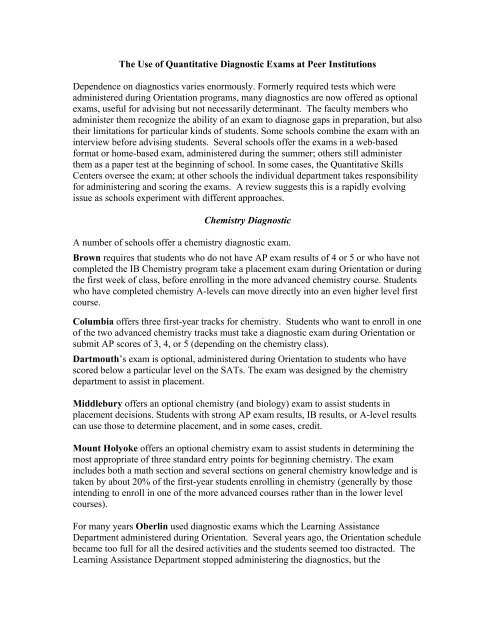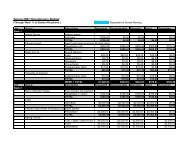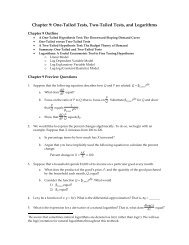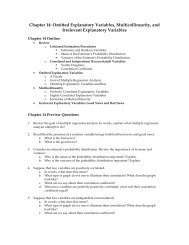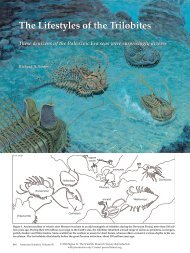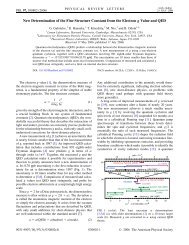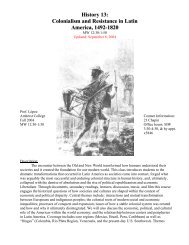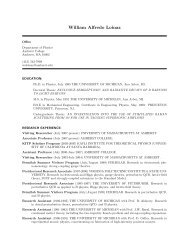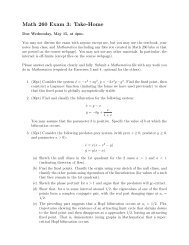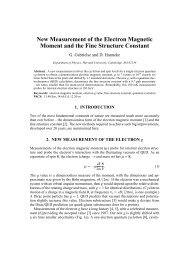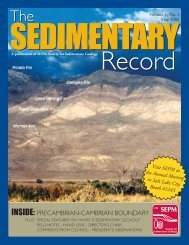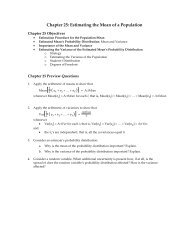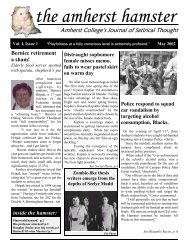Summary of quantitative skills diagnostics - Amherst College
Summary of quantitative skills diagnostics - Amherst College
Summary of quantitative skills diagnostics - Amherst College
Create successful ePaper yourself
Turn your PDF publications into a flip-book with our unique Google optimized e-Paper software.
The Use <strong>of</strong> Quantitative Diagnostic Exams at Peer InstitutionsDependence on <strong>diagnostics</strong> varies enormously. Formerly required tests which wereadministered during Orientation programs, many <strong>diagnostics</strong> are now <strong>of</strong>fered as optionalexams, useful for advising but not necessarily determinant. The faculty members whoadminister them recognize the ability <strong>of</strong> an exam to diagnose gaps in preparation, but alsotheir limitations for particular kinds <strong>of</strong> students. Some schools combine the exam with aninterview before advising students. Several schools <strong>of</strong>fer the exams in a web-basedformat or home-based exam, administered during the summer; others still administerthem as a paper test at the beginning <strong>of</strong> school. In some cases, the Quantitative SkillsCenters oversee the exam; at other schools the individual department takes responsibilityfor administering and scoring the exams. A review suggests this is a rapidly evolvingissue as schools experiment with different approaches.Chemistry DiagnosticA number <strong>of</strong> schools <strong>of</strong>fer a chemistry diagnostic exam.Brown requires that students who do not have AP exam results <strong>of</strong> 4 or 5 or who have notcompleted the IB Chemistry program take a placement exam during Orientation or duringthe first week <strong>of</strong> class, before enrolling in the more advanced chemistry course. Studentswho have completed chemistry A-levels can move directly into an even higher level firstcourse.Columbia <strong>of</strong>fers three first-year tracks for chemistry. Students who want to enroll in one<strong>of</strong> the two advanced chemistry tracks must take a diagnostic exam during Orientation orsubmit AP scores <strong>of</strong> 3, 4, or 5 (depending on the chemistry class).Dartmouth’s exam is optional, administered during Orientation to students who havescored below a particular level on the SATs. The exam was designed by the chemistrydepartment to assist in placement.Middlebury <strong>of</strong>fers an optional chemistry (and biology) exam to assist students inplacement decisions. Students with strong AP exam results, IB results, or A-level resultscan use those to determine placement, and in some cases, credit.Mount Holyoke <strong>of</strong>fers an optional chemistry exam to assist students in determining themost appropriate <strong>of</strong> three standard entry points for beginning chemistry. The examincludes both a math section and several sections on general chemistry knowledge and istaken by about 20% <strong>of</strong> the first-year students enrolling in chemistry (generally by thoseintending to enroll in one <strong>of</strong> the more advanced courses rather than in the lower levelcourses).For many years Oberlin used diagnostic exams which the Learning AssistanceDepartment administered during Orientation. Several years ago, the Orientation schedulebecame too full for all the desired activities and the students seemed too distracted. TheLearning Assistance Department stopped administering the <strong>diagnostics</strong>, but the
Chemistry department continues to require a placement exam during Orientation forstudents who wish to enroll in Chemistry 103, rather than 101 or 102.Pomona requires a placement exam for all students interested in taking the acceleratedchemistry program.Swarthmore <strong>of</strong>fers a department placement exam during Orientation to students whowant to take honors chemistry. Alternatively, students may submit AP results or IBresults to qualify for placement in honors chemistry.Yale requires a placement exam during Orientation for students who wish to elect one <strong>of</strong>the three advanced chemistry courses for freshmen. All other students planning to studychemistry are assigned, based on their high school background in chemistry, to one <strong>of</strong> thethree introductory level chemistry classes.Math DiagnosticMath <strong>diagnostics</strong> seem to be used almost exclusively by schools that have math or<strong>quantitative</strong> distribution requirements. Most use the exam to identify under-preparedstudents who may need special courses to ameliorate skill gaps. In many cases, the examis taken on a voluntary basis (among the schools on this list, only Wellesley and Williamsseem to require the exam).Brandeis <strong>of</strong>fers a self-administered exam to help students determine their appropriatemath placement, followed by a required exam (or successful completion <strong>of</strong> theprerequisite course) for any student opting for math courses other than pre-calculus.Brown <strong>of</strong>fers an optional self-grading, multiple-choice math placement exam duringOrientation. They encourage students who do not have AP scores to take the exam sothey can use the results in determining the most appropriate math course.Carleton <strong>of</strong>fers students the option <strong>of</strong> taking one <strong>of</strong> three math placement exams over thesummer before freshman year: a diagnostic exam (for those considering Calculus withReview or Calculus I) and two AP exams (for those considering either Calculus I vs. II,or II vs. III). Carleton limits enrollment in Calculus with Review to students who havenot had calculus in high school and who have scored below 625 on the SAT or 27 on theACT and scored poorly on the diagnostic. At the same time, they do not preventstudents who have not taken the diagnostic from enrolling in Calculus I. Until two yearsago these placement exams were administered on the first day <strong>of</strong> Orientation. Nowstudents receive the exams over the summer and return them before August 1st, soadvisors can review the exam results with the students when they arrive on campus.
At Columbia, advisors use AP scores or high school grades to determine the mostappropriate first course in calculus.At Dartmouth the exam is optional, though recommended, based on SAT scores, and isadministered by the Math department during Orientation. The Math department hasresponsibility for devising the test and determining the appropriate placementrecommendations, although students may elect to skip the test and also to ignore thedepartment’s advice.Until about two years ago Harvard required students to take a Quantitative Reasoningtest during Orientation and required students who scored below 20 points to enroll in a<strong>quantitative</strong> course. They have dropped the test (which distinguished somewhatarbitrarily between those who had adequate <strong>quantitative</strong> <strong>skills</strong> and those who did not) andnow require all non-science/math majors to take one <strong>of</strong> a selection <strong>of</strong> QR courses.Middlebury <strong>of</strong>fers two calculus-readiness placement exams for students. Students maysubstitute results from IB, AP or A-level exams.MIT has a mandatory math diagnostic, which students take over the summer andadvisors consult during Orientation in determining the appropriate calculus class for allfirst-year students. The exam includes problems in the areas <strong>of</strong> algebra, geometry,analytical geometry, trigonometry, exponentials and logarithms.This year Mount Holyoke is <strong>of</strong>fering a placement exam in <strong>quantitative</strong> <strong>skills</strong> for the firsttime.For many years Oberlin relied on a math diagnostic administered by the LearningAssistance Program during Orientation. Although the Learning Assistance Program nolonger administers the math diagnostic, the Math department requires students who areinterested in taking a course in either calculus (Math 131, 132, or 133) or elementarystatistics (Math 113 or 114) to take a math placement test which the department itselfadministers. For students interested in enrolling in other math courses, faculty advisorsrely on students’ SAT scores and ACT scores to determine whether the course isappropriate.Pomona requires that all students who wish to enroll in a mathematics course take a mathdiagnostic exam to determine appropriate math placement.Swarthmore considers AP or IB results, or the results <strong>of</strong> their own exams (calculusreadiness exam or calculus exam), which they mail to students over the summer. Theyalso <strong>of</strong>fer the exams during Orientation.Wellesley has two separate <strong>diagnostics</strong>. The QR Program sends incoming students a QR<strong>skills</strong> booklet to help them prepare for the QR Assessment that is administered duringOrientation. About 6-10% <strong>of</strong> incoming students score poorly on that are required to takea "QR Basic Skills" course in their first year to improve their <strong>skills</strong> in logic, basic mathand basic statistics. The Mathematics Department send students a separate math
placement exam to be completed over the summer and mailed to the <strong>College</strong>. The results<strong>of</strong> that math placement exam are combined with information on SAT scores, high schoolmath courses and grades, and AP credits to determine placement in a student’s first mathcourse. Students with questions about their math placement may meet with members <strong>of</strong>the Mathematics Department during Orientation.Wesleyan requires all incoming first-year students to take an online math test prior toarriving on campus, regardless <strong>of</strong> whether the student intends to study math at Wesleyan.Students must return the test to the college before the beginning <strong>of</strong> August so the resultswill be available for advising.Williams administers a <strong>quantitative</strong> <strong>skills</strong> test to all students and requires those whoperform poorly on the test to remedy their shortcoming with appropriate coursework.They are now in the process <strong>of</strong> adjusting the test to be less science-specific. The testincludes 20 questions from high school algebra, geometry, and pre-calculus, and studentshave an hour to complete the exam. The math pr<strong>of</strong>essor who teaches the course gradesthe exams. Within hours <strong>of</strong> the exam, he notifies about 100 <strong>of</strong> the 500 incoming studentsthat they need to come in for an interview. Two or three counselors meet with thestudents for 5-15 minutes for personal interviews.Of these, they ultimately place about 50 students in QS, Pre-calculus (primarily thosewho are potentially heading towards a gateway science course), and sometimes Stat 101,depending on their interests. The other 50 they counsel on their science requirements,inform them <strong>of</strong> the resources available on campus for help in math, invite them to comeback in the future if they need some advice, and send them on their way.Although Yale does not <strong>of</strong>ficially <strong>of</strong>fer a placement exam in math, a math pr<strong>of</strong>essor hasdeveloped a web-delivered multiple choice quiz that tests students’ mastery <strong>of</strong> centraltopics in pre-calculus. When implemented it will provide students with immediatefeedback about topics in need <strong>of</strong> review and will also provide instructors with statisticsabout class weaknesses, so that they can determine what topics they may need to reviewbefore launching into new material. He also plans to develop a similar exam for calculus2, testing what students remember from calculus 1. Once he has the assessment exams inoperation, he will begin gathering data on the effectiveness <strong>of</strong> this approach.


